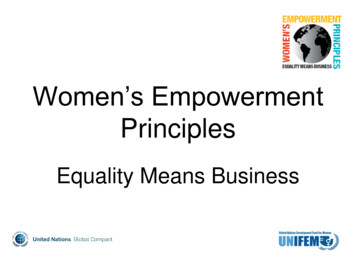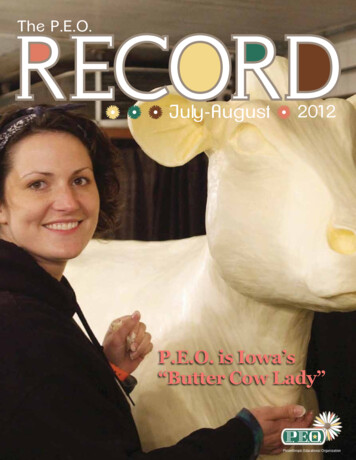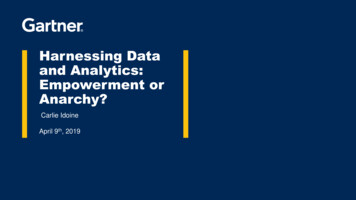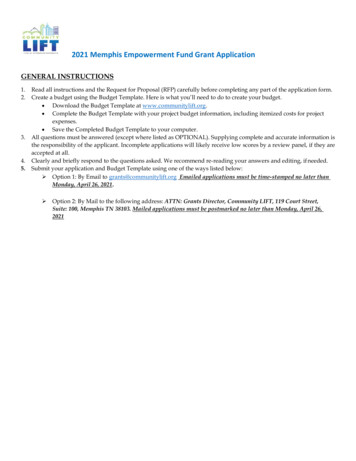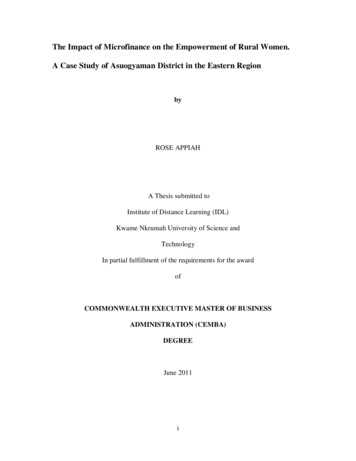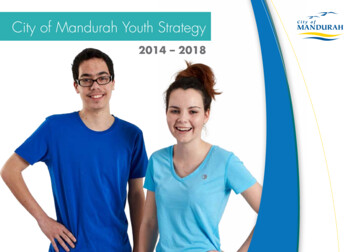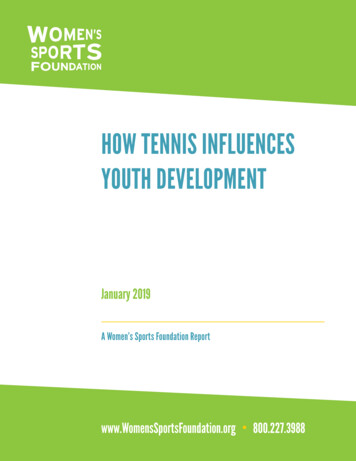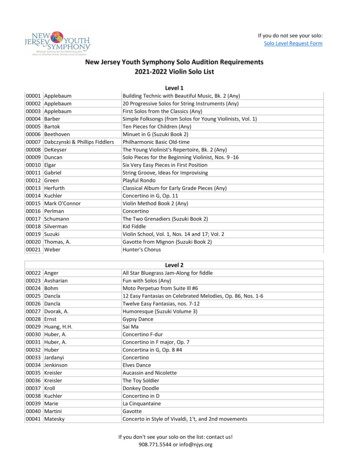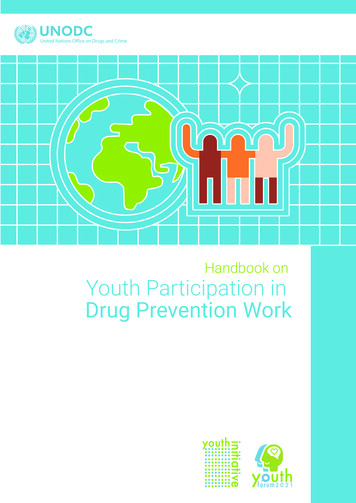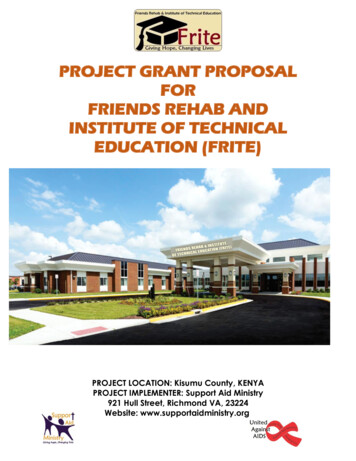
Transcription
WOMEN & YOUTH EMPOWERMENT PROJECT, KIBERAMASHIMONIPROJECT # 001ANGAZA COMMUNITY PROJECTOctober 10, 2013Authored by: Carole
PROJECT PROPOSALGeneral InformationName of Organisation:Angaza Community ProjectProject Title:Women and Youth economic empowermentProject Location:Nairobi County, Kibera.Contact Person:Peter MugeniContact Information:Kibera, Mashimoni Sub-locationP.O Box 21468-00505Nairobi, Kenya.Tel: 254 728 372 706/ 722 171 175Email: angazacp@gmail.comProject Timeline:Jan 2014- Dec 2016Amount Requested:2,235,050 Ksh (USD 27,938.125)1 Page
ContentsExecutive Summary. 3Problem Statement . 4Project Objectives: . 5Project long term goal: . 5Purpose/outcome: . 5Deliverables/outputs: . 5Expected impact/results of the project . 5Alignment of the project objectives to the CBO’s strategic plan. 6Project Implementation and Management Plan: . 7Project Monitoring and Evaluation: . 11Documentation and Sharing Results:. 132 Page
Executive Summary:Angaza Community Project is a Community Based Organisation (CBO) registered in June 2012 under anAct of Societies with the office of the District Gender and Social Development Officer (DGSDO). It is anorganisation that envisions to reach out with the love of God to the suffering as a result of the effectsof poverty, disease, ignorance , death and endeavors to address the root causes of these challenges inthe slums of Kibera situated in Nairobi, Kenya.The organisation’s vision is “to have a healthy empowered and productive society” and its mission is “to see people living harmoniously with God and each other, their environment and self, by espousingthe tenets of a holistic healthy lifestyle devoid of basic needs often brought about by combinedeffects of disease, ignorance and death.”Since inception in the beginning of 2011, Angaza Community Project’s Strategic areas has included thefollowing:i.ii.iii.iv.v.To promote health education and enhance prevention of diseases and illnesses includingresponse to HIV/AIDS among the infected and affected.To empower women and youth economically through equipping them with relevant skills andknowledge in microfinance and resource mobilizationImproved literacy levels among the children, youth and adults through support of formalvocational trainingsSpiritual hope through Jesus Christ shared through Bible studies and discussions with hurtingcommunitiesPromote psychosocial support and provide referral services to the needy in the communityThis project proposal focuses on women and youth empowerment in Kibera slums. Angaza CommunityProject is working towards developing the entrepreneurship skills of the community so as to get themout of the cycle of poverty. This way the project shall contribute towards addressing part of themillennium development goals and Kenya’s vision 2030. Several activities have been outlined such asbeadwork, shampoo and soap making, capacity development, mentorship and market linkages withrelevant institutions. We believe by the end of the project timeline, there shall be significant positivechanges in the lives of the beneficiaries which shall cascade to the community and beyond.3 Page
1.0Problem Statement:Kibera is estimated to be the largest slum in Africa with a population nearing 1.7 million people living ina 2 miles radius, and the population continues to grow. It is a most crowded settlement and itspopulation density is estimated at about 36 square feet per person. Kibera has very little or noinfrastructure with open sewers and drains everywhere. As one walks through Kibera, one feels thehuman proximity and its by-products: open sewage, open garbage dumps, mud walled houses and manymore eye sores. There are almost no government schools and hospitals to meet the demand. Despite ofthese miserable conditions, Kibera is an environment booming with small scale business activities ofevery kind. Most of the services are provided by individuals, religious bodies and various organisationsthat are either community led or charitable in nature.Like in a number of other pockets of Kibera community, conditions in Mashimoni sub-location, which isthe project area is equally dire, and most of its residents, being an urban setting have poor access tobasic services, including electricity, running water, descent housing and most importantly adequatefood. Some people who have nothing to do languish in poverty and spend time begging and orparticipate in unethical and anti-social behaviours. Despite of all these, and beyond the basic needs, thefamilies also need to take their children to school and try the much they can to provide them withbetter upbringing in a holistic manner (intellectually, socially and spiritually) that help them to be betterpeople in the society and break this vicious circle of poverty and dependency.In endeavor to cope with the situation or deal with it, most of the households, through their caregiverswho are able to eke out a living through casual labour in the industrial areas and nearby estates whileothers operate simple groceries among others.The desire to address the root causes of these challenging economic situation and their multipliernegative effects in the social behaviors among the residents of the project area is what drives thecommitment of Angaza Community Project. Through its affiliation to existing institutions like the churchand other stakeholders, the project endeavours to contribute to its long term strategy of economicempowerment of HHs in line with MDG on eradicating extreme poverty and hunger and empoweringwomen as well as contribute towards economic issues of the women and youth in line with Kenya’sVision 2030.Angaza project therefore, through this project, intends to make an impact in the lives of women (whoare mainly caregivers in households) and youth by improving its support to the current ongoinginitiatives such as on artwork (beadwork) and crafts among the women and capacity building of youthand women to equip them with relevant skills in economic empowerment. The motivation here is totake the initiatives to a new level that will help the involved target groups to generate income andaddress their basic needs at their household level as well as to save for other economic activities by endof 2016.4 Page
2.0Project Objectives:This is intended to be a long term project in which planned interventions will be implemented in aperiod of three (3) years after which a review shall be conducted. The target beneficiaries for thisproject are the women and youth who are working with Angaza Community Project.Project long term goal:In the long term this project aspires to see; Improved livelihoods for marginalized women and youth inKibera community by 2016Purpose/outcome:The main purpose of this project is;Increased income earning capacity of 300 women and youth in Kibera community by end of year 2016This shall be achieved through the following activities: Hold 12 training workshops on entrepreneurship & small business management for 200 women& 100 Youth.Provide low-interest loans in the form of revolving funds & group savings & loans (GSL) to 150women & 50 youths trained in small business managementHolds 3 training workshops for 60 community business support mentorsHold 18 livelihood support group meetings for IGA beneficiariesLiaise with and link trained women and youth to existing community microfinance institutions &banks for further support.Run 1 induction course for key programme personnel on effective programme development, M& E, reporting & fundraisingDeliverables/outputs:The project is expected to deliver the following in the course of its implementation;Output 1.1Capacity of 200 women built on IGAs for increased HHs economic resiliencyOutput 1.2100 Youth equipped with knowledge and skills on ICT and IGAOutput 1.350 trained women supported to establish viable IG through beadworkOutput 1.430 youth facilitated to market their IGA waresOutput 1.5Community members (women and youth) linked to saving and credit institutionsOutput 1.6Project interventions effectively executed with efficiency and accountabilityExpected impact/results of the projectThe indicators of success in accomplishing the above indicators will include:5 Page
At the outcome/level of effects and practice: Change in average income of the women at HH level (include expended per person perday)Change in income of the youth trained and engaged in economic initiativesNumber of Youth who are engaging in new IGA initiatives as a result of Capacity buildingsupportTrained women who have started other new IGA/initiatives on their ownAt mid-term Number of women trained and supported through IGAsNumber of youth provided with training (ICT and IGA)Number of youth engaged in marketing of their IGA waresNumber of women and youth linked to microfinance institutionsNumber of women and youth who have adopted the savings and creditNumber and type of branded art wares and crafts designed and sold100% completion of plans and acceptable varianceAlignment of the project objectives to the CBO’s strategic planThis project’s goal is derived from Angaza Organisation’s vision, which is- “to have a healthy,empowered and productive society.”But under the Women and Youth Economic Empowerment Project, the CBO endeavors to contribute toits organizational goal above through the outcome (project goal) of improved livelihood amongstWomen and Youth in Kibera community by 2016.In terms of strategic planning, the organisation has strategic plans that are designed to run for 3 yearcycles. This project goal is therefore designed to contribute to the first strategic outcome on access toaffordable and sustainable livelihood opportunities among the vulnerable community members withspecial emphasis on women and youth to enable them improve their incomes and living standards.Currently we have 50 women and youth who have acquired the knowledge and skills in artwork andcrafts through self-support and continuous training and practice. Such a process without a formaltraining set up takes time and in the process only a handful of them have the skills. Nevertheless theskills are helpful and that is in the areas of; purchasing beads, the art of doing the actual beadwork, withthe experienced ones being able to train others and instill the patience in them.6 Page
3.0Project Implementation and Management Plan:The Angaza project will partner with Safaricom foundation and other like-minded CBOs and thecommunity to implement project’s interventions in endeavor to realize the intended goals. This will bedone by facilitating the women and youth to be the implementers of the project while Angaza CBO offernecessary coordination, monitoring and reporting support. County government departments will also bean integral part of the project at Mashimoni sub-location.Community capacity building is a strategy that the project will adopt as a means of realizing communityempowerment, ownership and sustainability of economic/income generation interventions undertaken.In relation to this, Angaza has supported youth and women to have leadership structure and this will betrained to manage and operate the project initiatives. The target women and youth will be mobilized toparticipate to contribute at least 25% towards the interventions both in kind and in cash thus creating asense of ownership in the project.The project will focus on increasing income generation capacity of women and youth throughinvolvement in the motivational training, capital material support, participation in the initiatives, givingthem exposure and also linking them to market opportunities and micro-finance institutions forsustainability.To effectively arrive at the intended objectives, the project has put in place the following plan detailsimplementation plan;The General plan for 3 yearsProposed activityTargetTime frame/YearResponsibleNotesBeneficiaries(#andtype: Year 1Year 2Year 3(2014)(2015)(2016)Q1-Q4Q1-Q4Q1-Q4women & youth)Output 1.1: Capacity of 200 women built on IGAs for increased HHs economic resiliency1.1.1 Conduct training for 200womenonshampoomakingbeadwork,andsoapACP,200 women****Africa,bankGoYeEquityACPisindiscussion withotherorganisationsand individualsto support thetraining7 Page
Proposed activityTargetTime frame/YearResponsibleBeneficiaries(#andtype: Year 1Year 2Year 3(2014)(2015)(2016)Q1-Q4Q1-Q4Q1-Q4women & youth)1.1.2 Exposure visit to nearbyindustry or organisationtolearnfrom200 women and 100ACPyouth*bestmanagement*practices and replicate1.1.3 youth***** management*resiliency.1.1.4 Purchase of materials fortrainingandcapacity200 women & 100youthACP**Projectcoordinator*buildingOutput 1.2: 100 Youth equipped with knowledge and skills on ICT and IGA1.2.1 Conduct training for 100100 youthGoyouth on IGA1.2.2 Purchase 2 computers for**Women and youthmanagement*Women and youthEquity bankACPICT training1.2.3 Purchase of materials for*Ye Africa,**training*ACPProjectcoordinatorOutput 1.3: 50 trained women supported to establish viable/sustainable IG through beadwork1.3.1. Set up a special beadworkWomenACP*room in Angaza centre1.3.2. Establish own centre tocombine learning activities forthe adult learners, youth andwomen in training in ICT andIGA8 PagemanagementWomen and youth*ACPmanagementNotes
Proposed activityTargetTime frame/YearResponsibleNotesBeneficiaries(#andtype: Year 1Year 2Year 3(2014)(2015)(2016)Q1-Q4Q1-Q4Q1-Q4women & youth)1.3.3Purchase100kgsofWomenassorted beadwork materialsACPProjectcoordinator*for use by the women onbeadworkOutput 1.4: 30 Youth facilitated to market their IGA wares1.4.1.ConductinductionYouthtraining for youth on sales andGoACP, Safaricom*marketing of artwork and crafts.1.4.2. Provide linkage of theYe Africa,foundationYouthACP,youth to the existing curios and**ACP proposessupport*other marketsofSafaricomfoundation tomarkettheprojectitemsdevelopedbythe youth andwomen1.4.3 Establish partnership onACPbranding/patenting of productsmanagement*Output 1. 5: Community members (women and youth) linked to saving and credit institutions1.5.1. Hold joint forum betweenthe Youth and Women onWomen and Youth**savings and credit services1.5.2 Provide linkage of theYouth and Women IGA groupsWomen & youth**to the MFIsOutput 1.6: Project interventions effectively executed with efficiency and accountability9 Page
Proposed activityTargetTime frame/YearResponsibleBeneficiaries(#andtype: Year 1Year 2Year 3(2014)(2015)(2016)Q1-Q4Q1-Q4Q1-Q4women & youth)1.6.1. Hold joint monitoring,Project team, womenreflection and learning with& ion,1.6.2HoldjointinductionWomen & youthACPmeetings with the women gsjointwithotherWomen , youth &project teamACP***** en,youth,barazas to pass messagescommunity1.6.5 Conduct rapid assessmentProject teamto establish baselines for the&ACP****coordinator10 P a g eimplementingteamACPmonitoring support1.6.7 Allowances for the projectteamACPindicators1.6.6 Coordinator to providemarketingProject* * * * * * * * * * * *Project coordinatorcoordinatorACP* * * * * * * * * * * * managementNotes
4.0Project Monitoring and Evaluation:Participatory community based monitoring of project activities and outputs will be done through fieldprojects visits, interviews and observation. On such visits monitoring indicators set in the M&E plan willguide and inform the process. Data collection and analysis will be done in a participatory manner andreports produced which will be for reference and decision making. Project reports will be compiled onquarterly basis and shared with stakeholders and funding institution (Safaricom Foundation).The most significant change/impact stories in the project will be captured through monitoring andevaluation and shared with all partners as evidence of expected positive changes among women andyouth.The women and youth will be empowered to monitor activities and outputs on regular basis as this willenhance ownership and sustainability of the project interventions. Proper record keeping andcommunity contribution will ensure that the project targets are achieved at the required period and in atransparent and accountable manner.At the end of the implementation phase, project review/evaluation will be conducted to measureimpact/results of the project against intended objectives. This will be done jointly with otherstakeholders. The results and lessons will be compiled and shared among stakeholders in form of areport. Project transition will take place when objectives of sustainability are achieved. This will comeout clearly during evaluation and reflections.To effectively deliver by tracking the project progress and putting corrective measures in place to lead tothe intended results; the project will be guided by the framework below. This framework will beessential in evaluating the project so as to improve the project efficiency, as the project moves along.ObjectiveIndicatorFrequencySource of dataResponsibleProject Goal: Improved livelihoods for marginalized women and youth in Kibera community by 2016Change in average income of women atProject outcome:IncreasedincomeearningHH level (include expended per day)capacity of Women and YouthChange in income of the youth trainedin Kibera community by endand engaged in economic initiativesof year 2016Number of youth who are engaging innew IGA initiatives as a result of capacitybuilding support.Number of trained women who havestarted other new IGA/initiatives on theirown11 P a g eQuarterlyInterviews,bookkeeping recordsBi-annuallyProjectcoordinator
ObjectiveIndicatorProject output:FrequencySource of ningcoordinator, Go YeOutput 1.1. Capacity of 200# of women trained and supportedvisits,women built on IGAs forthrough IGAsreportsincreasedHHsandMFIreportseconomicAfrica and thyouthknowledge# of youth provided with training (ICT &IGA)and skills on ICT & IGAOutput1.3. 50 trained women# and type of branded art waressupported to establish viabledeveloped and soldIG through beadworkOutput1.4.facilitated to30youthmarket IGA# of youth engaged in marketing of theirIGAs warewaresOutput1.5.Communitymembers(women and youth)# of women and youth linked to microfinance institutions.linked to saving and creditinstitutions# of people (women and youth) who haveadopted the savings and creditOutput1.6.interventionsProject100% completion of the plans and reporteffectivelyexecuted with efficiency andaccountability12 P a g eMonthlyMonthlyreports,financial accountsAcceptable budget: expected varianceProjectcoordinator
5.0Documentation and Sharing Results:Right from the start of the project, the target community in Mashimoni will be involved throughmeetings and forums meant to enlighten the women and youth on the purpose of the project. Theyouth and women who are already working in the project will work as agents of mobilization so thatthey dispel any negative fears from those with interest.In the course of actual delivery of the plans, the women and youth will be key in the industrial aspect ofmaking and producing the artwork items and crafts for sale. They will play an active role in seekingmarkets, distribution and selling of the products. They will also get opportunities to participate in talkshocks in the local media stations. Angaza Community Project shall also work in conjunction withSafaricom foundation to publicize the items.As described in the monitoring and evaluation section above, the project will facilitate regular jointreviews and reflection forums to make informed decisions and chart the best course of the projectbased on the continuous monitoring data that will be collected in the project. The project leadership willplay its role of disseminating any necessary information to members, such as monitoring reports, specialreports such as the financial standing of the project, successes and even areas that requireimprovement.Records for all the stock movements, materials acquired and sold as well as budget expenditure will bewell kept and availed relevantly where necessary.This will be key in sensitizing the community on economic issues, enhancing branding of the project andownership as well as instilling accountability in a manner to ensure sustainability.13 P a g e
6.0Project Budget:Planned Activity/ItemQuantityUnit cost (Ksh)Total cost (Ksh)Budget notes1USD 80KshOPERATIONAL COSTSAdministrationCommunication330,000 per yearSub totals19455010% of total budget90,000Calling cards, internetcharges284550PROGRAM COSTSTraining workshops onentrepreneurship and smallbusiness management12Venue2500 @2days (12 workshops)60,000Stationeries30080 @2days48,000Refreshments310100 @2days (12 workshops)744,000Facilitation fee21500@2days (12 workshops)72,000Total for entrepreneurship &small business managementTraining workshops forbusiness support mentors924,0003Venue2500 (3 workshops)7,500Refreshment60100 (3 workshops)18,000Stationeries6080(3 workshops)14,400Facilitation fee21500(3 workshops)Total for business supportmentorsLivelihood support groupmeetings for IGAbeneficiariesVenue14 P a g e9,00048,900182,500(18 meetings)45,000Facilitation costs shall becovered by Go Ye Africaand Equity Bank
Planned Activity/ItemQuantityUnit cost (Ksh)Total cost (Ksh)Budget notes1USD 80KshRefreshment150100 (18 meetings)270,000Facilitation fee11500 (18 meetings)27,000Total for IGA beneficiaries150 IGA beneficiaries342,000Induction course for keyprogramme personnel oneffective programmedevelopment, M&E,reporting and fundraising1Conference hall11,500@3daysAccommodation63000@ 3 nights54,000Meals6450@ 3 days8,100Facilitator11500@3 days4,500Totals for induction course4,500Intensive residentialtraining for staff71,100Sub totals1,386,000OTHERSEstablishing a bead-makingtraining facilityOffice space1Furniture (tables & chairs)8,000@ 12 months (3 years)288,0005,500@3 tables81,5003 wooden tables and100 plastic chairs95,000100kg beads, needles,thread, cloth650@100 chairsMaterials for bead work100950Whiteboard140,00040,000Storage facility160,00060,000Sub totalsGRAND TOTALS15 P a g e469,5002,235,050Metallic/woodenlockable cabinet
these miserable conditions, Kibera is an environment booming with small scale business activities of every kind. Most of the services are provided by individuals, religious bodies and various organisatio

